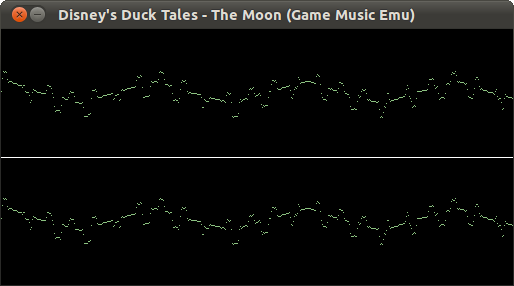I’m trying to figure out how to write a software oscilloscope audio visualization. It’s made more frustrating by the knowledge that I am certain that I have accomplished this task before.
In this context, the oscilloscope is used to draw the time-domain samples of an audio wave form. I have written such a plugin as part of the xine project. However, for that project, I didn’t have to write the full playback pipeline– my plugin was just handed some PCM data and drew some graphical data in response. Now I’m trying to write the entire engine in a standalone program and I’m wondering how to get it just right.

This is an SDL-based oscilloscope visualizer and audio player for Game Music Emu library. My approach is to have an audio buffer that holds a second of audio (44100 stereo 16-bit samples). The player updates the visualization at 30 frames per second. The o-scope is 512 pixels wide. So, at every 1/30th second interval, the player dips into the audio buffer at position ((frame_number % 30) * 44100 / 30) and takes the first 512 stereo frames for plotting on the graph.
It seems to be working okay, I guess. The only problem is that the A/V sync seems to be slightly misaligned. I am just wondering if this is the correct approach. Perhaps the player should be performing some slightly more complicated calculation over those (44100/30) audio frames during each update in order to obtain a more accurate graph? I described my process to an electrical engineer friend of mine and he insisted that I needed to apply something called hysteresis to the output or I would never get accurate A/V sync in this scenario.
Further, I know that some schools of thought on these matters require that the dots in those graphs be connected, that the scattered points simply won’t do. I guess it’s a stylistic choice.
Still, I think I have a reasonable, workable approach here. I might just be starting the visualization 1/30th of a second too late.